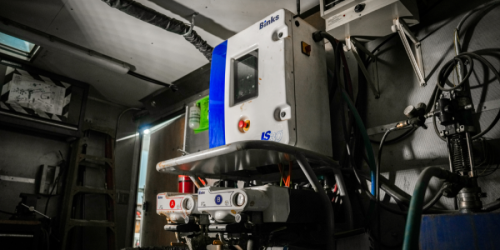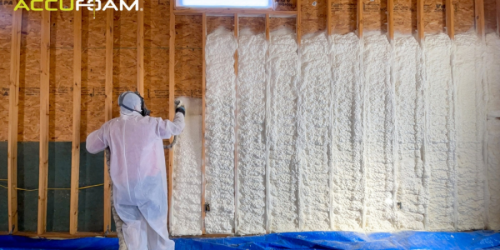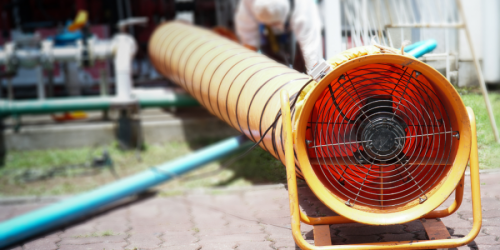Q&A Forums
Thickness of Open cell foam Post New Topic | Post Reply
| Author | Comments |
|---|---|
|
Posted: Jul 14, 2009 10:41 AM
|
Thickness of Open cell foam
I have done a few applications of the open cell foam to the underside of gable roofs with great success. I have always applied 8" nominal 1/2 lb. open cell foam, which usually turns out to be around 10". I have a quote from a subcontractor using 5.5" of 1/2 lb. foam, and he tells me that anything more is a waste. The other sub, using the 8" nominal tells me that when you start getting into the more extreme temps (Jobs are all in Chicago, using a 5.5" thick application on the underside of the roof will not perform. Does it make sense to use the thicker application, or should I start using the thinner application and save money?
|
|
mason
Posted: Jul 14, 2009 10:56 AM
|
There is a diminishing return on energy performance value with increased thickness. But, you also have to satisfy code requirements. There is strong research evidence to indicate that 5.5 inches of open cell foam provides the same energy efficiency of R 38 of blown in fiberglass in attic floors. So, the code official has the option of using that type of data to allow lessor thickness of insulation. But, if you require an R 49 in your area, then you would need more to satisfy code requirements. There is a presentation that Roger Morrison made at the annual Sprayfoam conference on Determining Insulation Thickness. Contact sprayfoam.org for a copy. |
|
Michael Fusco
Posted: Jul 15, 2009 05:09 PM
|
Interesting..."5.5 inches of open cell foam" under the roof "provides the same energy efficiency of R38 of blown in fiberglass in attic floors." I added the under the roof since that was the question....am I the only one that seems to feel that this makes no sense....we are not comparing apples to apples..... My biggest concern here would be thermal bridging....but that would not be a concern on the floor...would it? |
|
mason
Posted: Jul 15, 2009 09:13 PM
|
We tested the performance of open cell foam at 5.5 inches on the underside of the roof deck (between the rafters) to R 38 of blown in fiberglass installed to the floor of the attic at Oakridge National Labs attic simulator. The results, the open cell foam performed equal to the fiberglass at hot and cold climates plus the foam attic maintained temperatures within 7-8 degrees if the interior temperature while the fiberglass attic was within 7-8 degrees of the outside temperature. Pretty convincing evidence. |
|
Michael Fusco
Posted: Jul 28, 2009 05:18 PM
|
How can you compare foam under the roof deck to fiberglass on the floor!!!!???? Noe even apples to apples. |
|
mason
Posted: Jul 29, 2009 07:25 AM
|
Urethaneman, That was the point, both applications are different and you can expect different results not only from the type of material used but also where it is placed. We discussed performing the test with foam sprayed to the floor of the attic, but it was rejected by the Task Group working on the project. Why? The testing was performed to approximate the most common applications of both products. Most blown in fiberglass is on the floor of the attic and most sprayfoam applications are to the underside of the roof deck. The test program was vetted by a number of building science professionals including, Dave Yarborough and Ron Graves (Ron is a former Chairman of ASTM C 16, the Thermal Insulation Committee of ASTM and a former employee of ORNL) with R & D Services, Jeff Christian with Oakridge National Labs, SPFA's Technical and Building Envelope Committee, Laverne Dalgleish with ABAA and others. The results demonstrate that sprayfoam (both open and closed cell) installed to the underside of the roof deck peforms 15 to 30% more efficiently than fiberglass blown in to the floor of an attic in cold and hot climates. In addition and just as important, the attic space insulated with foam to the underside of the roof deck maintains temperatures within 7-8 degrees of the interior temperature. This is important if HVAC units and/or ductwork is in the attic space. Vented attics maintain temperatures similar to the outside temperature. In warm environments the attic can be 10 to 30 degrees hotter than the outside temperature (depending on the color of the shingles or roof membrane). So in those attics cold or hot air flowing through the ductwork would be nullified by the ambient temperature within the attic space. (this test did not take into consideration air infiltration, if it were, the results would most likely be even more dramatic. |
|
Michael Fusco
Posted: Jul 30, 2009 09:22 AM
|
Mason, I don't disagree with what was done....I disagree with your statement that this test shows foam mimicks an R-38 with fibreglass. Until you compare apples to apples, you can't draw that conclusion. Maybe we just agree to disagree on this one. |
|
mason
Posted: Jul 30, 2009 11:20 AM
|
It was not my intention to suggest that SPF mimicks fiberglass. Totally different physical properties and qualities. I only was suggesting based on testing at ORNL, ATI, Syracuse and other places that at the minimum, the energy performance of sprayfoam at 3-4 inches (closed cell and 5.5 to 7 inches is equivalent in many tests to R 38 of blown in fiberglass. (I would agree that sprayfoam performs much better than that in many cases, depending on the temperature extremes, thermal bridging and relative air tightness of the assembly. For example sprayfoam installed as a roofing system over metal deck could have 3-5 times greater energy efficiency than fiberglass batts installed to the underside of that same metal deck. |





























